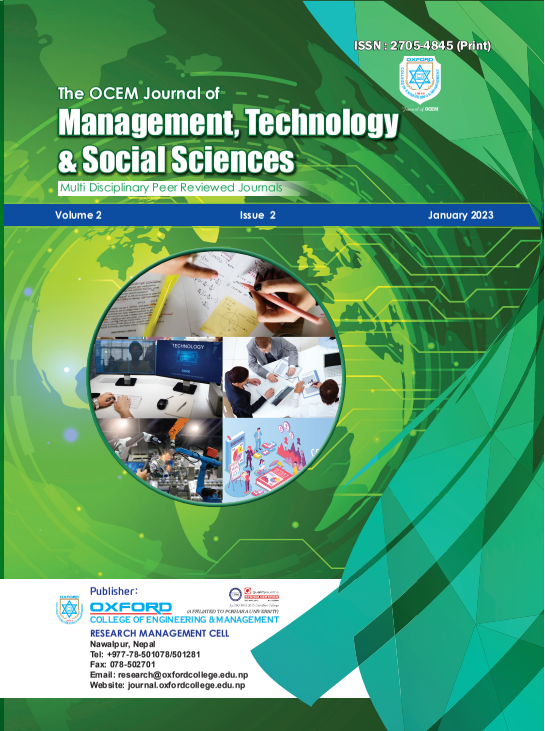Relationship Between Internet Scrolling Habit and Social Media Marketing
Abstract
The previous study has concluded that internet scrolling is required to generate business, and social media employs psychological techniques to advertise for business purposes. The primary objective of this study was to investigate the opinions and experiences of bachelor’s level students on the role of internet scrolling addiction impact on social media marketing. This study applied the quantitative approach and the survey instrument to collect data. The sample population was two hundred bachelor’s level students at Oxford College of Engineering and Management. A random sampling method was used to select sample students among three thousand students
The results show a significant association between internet scrolling habits and observing social media marketing, implying a negative association with using social media marketing (p < 0.05). Similarly, there was a positive association between social media marketing and influence on chatting apps (p < 0.05). Further, the results indicated a negative association between time of activeness and the use of social media with social media marketing. This study's implication would benefit social media marketers, students, scholars, entrepreneurs and owners of social media marketing businesses.
Keywords:
Implication, higher-level students, Internet scrolling habit, positive and negative association, social media marketing,Downloads
References
Alalwan, A. A., Rana, N. P., Dwivedi, Y. K., & Algharabat, R. (2017). Social Media in marketing: A Review and Analysis of the Existing Literature. Telematics and Informatics, 34(7), 1177–1190.
Aryal, M. (2019, December 12). Internet Habit In Young People Rise In Nepal. ICT Frame. https://ictframe.com/young-internet-addicts-on-the-rise-in-nepal/ Available at https://doi.org, accessed on 27th November 2022
Azpeitia, J. (2021). Janell Azpeitia Social Media Marketing and its Effects on TikTok Users International Business 2021. Available at https://www.theseus.fi , and accessed on 24th November 2022
Bunce, D. M., Flens, E. A., & Neiles, K. Y. (2010). How Long Can Students Pay Attention in Class? A Study of Student Attention Decline Using Clickers. Journal of Chemical Education, 87(12), 1438–1443.
Chapman, C., & Muijs, D. (2013). Collaborative School Turnaround: A Study of the Impact of School Federations on Student Outcomes. Leadership and Policy in Schools, 12(3), 200–226.
Chen, H. (2017). College-Aged Young Consumers' Perceptions of Social Media Marketing: The Story of Instagram. Journal of Current Issues & Research in
Advertising, 39(1), 22–36. Available at https://doi.org/10.1080/10641734.2017
.1372321d, and accessed on 24th November 2022
Cheung, M. L., Pires, G., & Rosenberger, P. J. (2020). The Influence of Perceived social media Marketing Elements on Consumer–Brand Engagement and Brand Knowledge. Asia Pacific Journal of Marketing and Logistics, 32(3), 695–720.
Çizmeci, E. (2017). No Time for Reading, Addicted to Scrolling: The Relationship Between Smartphone Habit and Reading Attitudes of Turkish Youth. Intermedia International E-Journal, 4(7), 290–302. Available at https://doi.org, and accessed on 24th November 2022
Coker, K. K., Flight, R. L., Baima, D. M. (2017). Skip It or View It: Coker, Flight and Baima 75 Marketing Management Journal, Fall 2017. Available at http://www. mmaglobal.org, and accessed on 24th November 2022
Collis, J., & Hussey, R. (2014). (PDF) Business research: A practical guide for undergraduate. (5th ed.). USA. Red Globe Press.
Creswell, J. W., & Creswell, J. D. (2018). Research design: Qualitative, quantitative, and Mixed Methods Approaches (5th ed.). SAGE Publications.
Digital Terai. (2020). Social Media Marketing in Nepal | The Ultimate Guide. Digital Terai. https://digitalterai.com/social-media-marketing-nepal
Gaddefors, L., & Tollqvist, F. (2017). Available at http://www.diva- https://www.divaportal.org, and accessed on 24th November 2022
Gomathi, A., & Veeramani, P. (2022). The Study on Social Media Habit Among Adolescents. ResearchGate; Available at https://www.researchgate.net and accessed on November 22, 2022.
Jamil, K., Dunnan, L., Gul, R. F., Shehzad, M. U., Gillani, S. H. M., & Awan, F. H. (2022). Role of Social Media Marketing Activities in Influencing Customer Intentions: A Perspective of a New Emerging Era. Frontiers in Psychology, 12. Frontiersin. Available at https://doi.org/10.3389/fpsyg.2021.808525, and accessed on December 25 2022.
Koessmeier, C., & Büttner, O. B. (2021). Why Are We Distracted by social media? Distraction Situations and Strategies, Reasons for Distraction, and Individual Differences. Frontiers in Psychology, 12. https://doi.org/10.3389/ fpsyg.2021.711416, accessed on 25th December 2022.
Kwak, Y., Kim, H., & Ahn, J.-W. (2022). Impact of Internet usage time on mental health in adolescents: Using the 14th Korea Youth Risk Behavior Web-Based Survey 2018. PLOS ONE, 17(3), e0264948. Available at https://doi.org Accessed on
27th November 2022
Lab, C. (2018). Types of Descriptive Statistics. Baseline Help Center. Available at https://baselinesupport.campuslabs.com Accessed on 26th November 2022
Lever, J., Krzywinski, M., & Altman, N. (2017). Points of Significance: Principal component analysis. Nature Methods, 14(7), 641–643.
Lupinacci, L. (2020). "Absentmindedly scrolling through nothing": liveness and compulsory continuous connectedness in social media. Media, Culture & Society, 43(2), 35-45
McDonald, J. (2018). Social Media Marketing Workbook : how to use social media for business. Canada. Createspace Indep Pub.
Rakhmawati, W., Kosasih, C. E., Widiasih, R., Suryani, S., & Arifin, H. (2021). Internet Habit Among Male Adolescents in Indonesia: A Qualitative Study. American Journal of Men's Health, 15(3), 15-26
Stanton, L. (2017). Goldfish Memory Span: How Long Is It? (Hint: NOT 3 Seconds). Hepper0. Available at https://www.hepper.com/, accessed on 27th November 2022
Walden University. (2010, January 1). 7 Research Challenges (And how to overcome them) | Articles | Walden University. Available at www.waldenu.edu. Accessed on 27th November 2022
Warokka, A. (2020). Digital Marketing Support and Business Development Using Online Marketing Tools: An Experimental Analysis. International Journal of Psychosocial Rehabilitation, 24(1), 1181–1188.
Wiederhold, B. K. (2018). Stop Scrolling, Start Living: The Growing Reality of Internet Habit Disorder. Cyberpsychology, Behavior, and Social Networking, 21(5), 279–280.
Downloads
Published
How to Cite
Issue
Section
License

This work is licensed under a Creative Commons Attribution 4.0 International License.
© 2024 by The OCEM Journal of Management, Technology and Social Sciences is licensed under CC BY-NC 4.0






